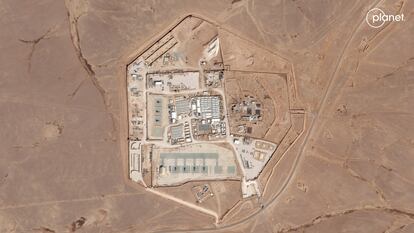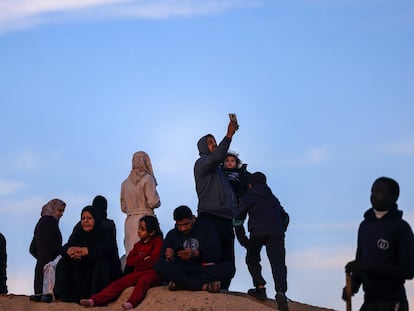The US mistook the drone that killed three of its military personnel in Jordan for one of its own
Washington argues that this misidentification allowed the attack, considered ‘an escalation’ in the conflict. The White House promises a response


Confusing an enemy drone with one of its own returning to base appears to be the factor behind the attack on a U.S. position in northeastern Jordan on Sunday, in which three U.S. servicemen were killed and 40 others were wounded, military officials said. The incident was the first to kill U.S. soldiers in a hostile act since the Israel-Hamas war started on Oct. 7. It increases pressure on Joe Biden as pro-Iranian militia attacks in the Middle East proliferate and the risk of regional escalation appears greater than ever.
According to the U.S. commanders’ account, the return of a U.S. drone to Tower 22, the attacked outpost near the Syrian border, caused confusion among those in charge of the air defense systems, who did not know if the approaching device was theirs. That doubt led to a delay in activating the defense systems. Two other unmanned aerial vehicles that attacked other U.S. positions were shot down without causing any damage, the commanders said.
The militia drone attacked the barracks that serve as a residential area inside the base, where 350 U.S. military personnel are stationed. Many of them were sleeping at the time. In addition to the three dead, another thirty soldiers were wounded in the incident.
On Monday, Biden met with his National Security team at the White House to discuss the situation after the attack in northeastern Jordan, near the Syrian border. According to the White House, those in attendance included National Security Advisor Jake Sullivan, Defense Secretary Lloyd Austin and National Intelligence Director Avril Haines.
The coalition of pro-Iranian militias in Syria and Iraq, known as the Islamic Resistance of Iraq (IRI), said on Sunday that it had attacked three U.S. positions in Jordan, including the Tower 22 base. Iran has denied any involvement in the attack on U.S. forces and described the incident as part of clashes between the U.S. and “resistance groups in the region.”
At Monday’s White House press conference, National Security Council spokesman John Kirby declined to confirm that the incident was caused by a misidentification. Like Biden a day earlier, he did say that the United States would respond to the attack: “We do not seek another war. We do not seek to escalate. But we will absolutely do what is required to protect ourselves […] and to respond appropriately to these attacks. […] This attack over the weekend was escalatory, make no mistake about it. And it requires a response, make no mistake about that.” Kirby emphasized that the response will come “at a time and place of our choosing.”
In a similar vein, at the start of a meeting with NATO Secretary General Jens Stoltenberg, Defense Secretary Lloyd Austin — who returned to his office at the Pentagon on Monday after recovering from complications from cance r— said that “the president and I will not tolerate attacks on U.S. forces and we will take all necessary actions to defend the U.S. and our troops.”
In regard to their retaliation, the White House and the Pentagon face a problem that has affected them since the beginning of the crisis: how to react with enough force to prevent future aggressions while also being restrained enough to avoid an escalation of unpredictable consequences.
The numbers speak for themselves. Since the war between Israel and Hamas began on October 7, U.S. forces have been the target of over 150 attacks, for which Washington blames pro-Iranian groups in increasingly more areas of the Middle East, from Houthi missile launches from Yemen to the Red Sea area to drone attacks on their positions in Iraq and Syria. In addition, there have been another 30 or so Houthi attacks on merchant ships.
Until now, the Biden administration has been relatively restrained in response to these militia strikes. In Yemen, U.S. strikes alone or in coordination with British forces had been limited to destroying rebel radar and missile sites. Its retaliatory military activities in Syria had similar objectives. Time and again, Washington has insisted that it sees no indication that Iran has any interest in being directly involved in the conflict.
Many analysts see a Washington response to the latest aggression as inevitable, but they warn of the consequences. The United States “will have to respond forcefully to this attack,” says William Wechsler, a former deputy secretary of defense who now works at the Atlantic Council think tank. But the U.S. must make sure that its reaction “minimizes the risk of provoking a wider regional war or forcing the Iraqi government to demand the withdrawal of the U.S. troops” still stationed on its territory, about whom the two governments are negotiating.
Among the options being considered at the Pentagon, experts point to seizing Iranian assets, including ships; attacking Iranian forces outside or inside that country; and continuing their relatively moderate strikes against pro-Iranian militias.
If Biden has resisted a direct strike against Tehran thus far, given the risk of a regional escalation, Republicans are clamoring for an attack on Iranian territory.
On X, formerly known as Twitter, Senator John Cornyn urged “target[ing] Tehran.” Later, he specified that he was calling for strikes against the Iranian Islamic Revolutionary Guard. Senator Lindsey Graham called on Biden to “hit Iran now. Hit them hard.” Senator Tom Cotton declared: “The only answer to these attacks must be devastating military retaliation against Iran’s terrorist forces, both in Iran and across the Middle East. Anything less will confirm Joe Biden as a coward unworthy of being commander-in-chief.”
On his social network Truth Social, former President and Republican presidential hopeful Donald Trump said: “We are on the brink of World War III.” He added that Sunday’s “brazen attack on the United States is yet another horrific and tragic consequence of Joe Biden’s weakness and surrender,” although he did not call for a specific U.S. response.
Sign up for our weekly newsletter to get more English-language news coverage from EL PAÍS USA Edition
Tu suscripción se está usando en otro dispositivo
¿Quieres añadir otro usuario a tu suscripción?
Si continúas leyendo en este dispositivo, no se podrá leer en el otro.
FlechaTu suscripción se está usando en otro dispositivo y solo puedes acceder a EL PAÍS desde un dispositivo a la vez.
Si quieres compartir tu cuenta, cambia tu suscripción a la modalidad Premium, así podrás añadir otro usuario. Cada uno accederá con su propia cuenta de email, lo que os permitirá personalizar vuestra experiencia en EL PAÍS.
¿Tienes una suscripción de empresa? Accede aquí para contratar más cuentas.
En el caso de no saber quién está usando tu cuenta, te recomendamos cambiar tu contraseña aquí.
Si decides continuar compartiendo tu cuenta, este mensaje se mostrará en tu dispositivo y en el de la otra persona que está usando tu cuenta de forma indefinida, afectando a tu experiencia de lectura. Puedes consultar aquí los términos y condiciones de la suscripción digital.
More information
Archived In
Últimas noticias
Chris Martin, Taylor Swift, Elijah Wood and other famous wedding ‘crashers’
‘How does it feel to be a failure?’: Elizabeth Berkley’s journey from ‘Showgirls’ ridicule to vindication
The story of the Málaga virus: The code that haunted Google’s cybersecurity center director for 30 years
The impact of Ecuador’s mega-prison: A polluted river, cleared forests and military checkpoints
Most viewed
- The low-cost creative revolution: How technology is making art accessible to everyone
- Christian Louboutin: ‘Young people don’t want to be like their parents. And if their parents wear sneakers, they’re going to look for something else’
- All the effects of gentrification in one corner of Mexico’s Colonia Roma
- Liset Menéndez de la Prida, neuroscientist: ‘It’s not normal to constantly seek pleasure; it’s important to be bored, to be calm’
- December Social Security and SSI payments: Dates, double checks and the 2026 COLA increase










































